The average UK house price climbed by 3.3% in the year to November, the latest UK House Price Index from the Office for National Statistics (ONS) has shown.
This annual rate of growth was up from 3% in October and took the average house price in November to £290,000.
According to ONS data, annual house price inflation has been generally increasing since its low point of -2.7% in the 12 months to December 2023.
The latest index showed that across the UK regions, average house prices jumped in England to £306,000 (3%), in Wales to £219,000 (3%) and in Scotland to £195,000 (4.7%). The average house price for Northern Ireland was £191,000 in Q3, a figure up 6.2% on the same quarter a year earlier.
“House prices may have nudged down slightly in November, but they are still up slightly over the year, once again showing the resilience of the market,” director at April Mortgages, Rachael Hunnisett, commented. “In part, this is due to the stamp duty holiday stimulating demand and partly by the chronic lack of available stock.
“Despite the volatility we have seen in January, and uncertainty around the economy, the one constant that persists is the demand for property in the UK.
“The elephant in the room is the impact of rising house prices on first-time buyers. While the desire to escape the expensive rental market and secure good-quality housing has never been stronger, the high cost of homes means that buying a home has become increasingly daunting hurdle for many.”
Head of mortgages at Atom bank, Richard Harrison, added: “The imbalance between housing supply and demand continues to drive house price growth. With housebuilding down 6% in 2023/24 and well below required levels, prices will likely keep rising to record levels unless construction rates increase significantly, as promised by the Labour government.
“The rush to beat the stamp duty increase from 1 April will also be a factor in fuelling house price inflation in the short term.”
Latest News
-
Nationwide fined £44m for financial crime control failings
-
Targeted support applications to open from March 2026
-
Second charge mortgage market continues growth
-
19 firms join forces to launch new retail investment campaign
-
Four in five bridging professionals confident about 2026 market outlook
-
GDP falls 0.1% month-on-month in October
Perenna and the long-term fixed mortgage market

Content editor, Dan McGrath, spoke to head of product, proposition and distribution at Perenna, John Davison, to explore the long-term fixed mortgage market, the role that Perenna plays in this sector and the impact of the recent Autumn Budget
The role of the bridging market and technology usage in the industry
Content editor, Dan McGrath, sat down with chief operating officer at Black & White Bridging, Damien Druce, and head of development finance at Empire Global Finance, Pete Williams, to explore the role of the bridging sector, the role of AI across the industry and how the property market has fared in the Labour Government’s first year in office.
NEW BUILD IN FOCUS - NEW EPISODE OF THE MORTGAGE INSIDER PODCAST, OUT NOW

Figures from the National House-Building Council saw Q1 2025 register a 36% increase in new homes built across the UK compared with the same period last year, representing a striking development for the first-time buyer market. But with the higher cost of building, ongoing planning challenges and new and changing regulations, how sustainable is this growth? And what does it mean for brokers?
Does the North-South divide still exist in the UK housing market?

What do the most expensive parts of the country reveal about shifting demand? And why is the Manchester housing market now outperforming many southern counterparts?
In this episode of the Barclays Mortgage Insider Podcast, host Phil Spencer is joined by Lucian Cook, Head of Research at Savills, and Ross Jones, founder of Home Financial and Evolve Commercial Finance, to explore how regional trends are redefining the UK housing, mortgage and buy-to-let markets.
In this episode of the Barclays Mortgage Insider Podcast, host Phil Spencer is joined by Lucian Cook, Head of Research at Savills, and Ross Jones, founder of Home Financial and Evolve Commercial Finance, to explore how regional trends are redefining the UK housing, mortgage and buy-to-let markets.
© 2019 Perspective Publishing Privacy & Cookies




.jpg)






Recent Stories